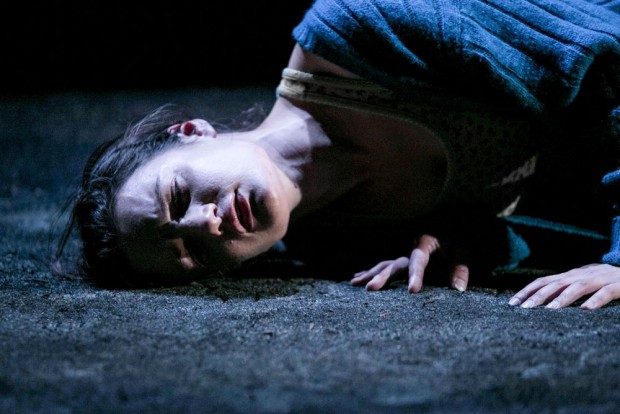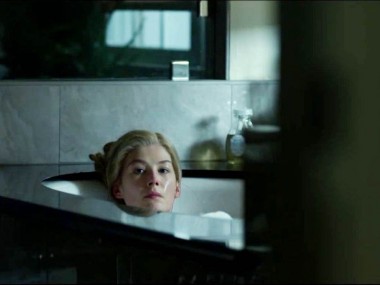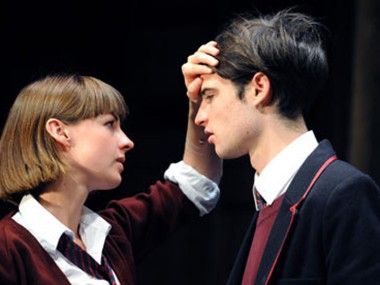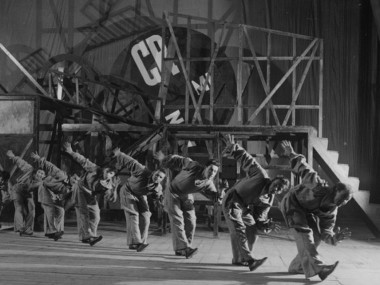A Girl Is a Half-Formed Thing, Young Vic
Friday 19th February 2016

Eimear McBride’s debut novel, the provocatively titled A Girl Is a Half-Formed Thing, won the first Goldsmiths Prize in 2013, as well as the Baileys Women’s Prize for Fiction a year later. This phenomenal book, which was written when McBride was 27 years old, but took nine years to find a publisher, has been adapted by Annie Ryan and is performed solo by Aoife Duffin with a compelling mix of bruised charm and sheer intensity. Having opened at the Dublin Theatre Festival in 2014, then wowed the Edinburgh Festival last year, it now visits London as part of a nationwide tour. Can it grip metropolitan audiences?
You bet. Firstly, it’s a book that was written as a stream of consciousness so it really does demand to be heard as well as read. In the original, a young woman communicates in a restless spillage of fragmented sentences, half-completed thoughts and bits of conversations and dialogue. It’s fast; it’s raw; it’s compelling in its pain and anguish. Definitely not a quiet read. Here Ryan and Duffin do the story justice by seamlessly turning a piece of literature into a performance event.
But be braced for the bleak. The nameless girl lives with her brother, who suffers from cancer of the brain, and their mother, a rather tyrannical and unsympathetic woman whose husband has left her. The stink of religious bigotry and a feeling of rural stupor pervades their lives. The innocence of childhood and the bond the girl forms with her sick brother, who is bullied at school, comes under strain during their adolescence. At one point, her uncle, a sleazy figure, begins to abuse her. As he kisses her, the stage darkens. Traumas accumulate and she leaves home for university, where she goes pretty wild: understanding her sexual power, she has sex with dozens of men.
At one point, there’s a poetic litany, in which girl repeats “I met a man”, detailing all the sexual encounters that distract her from inner pain, but fill her with self-hate. In fact, she discovers that the best way of numbing her mental pain is to experience physical pain, so she provokes violence, sickening violence. The double binds of her family’s emotional life trap her in their coils, and a picture of damage and self-harm glows like a dark diamond in the gloom of the evening.
Watching A Girl Is a Half-Formed Thing feels like listening to the debut album of a talented singer-songwriter. Maybe young Patti Smith. Maybe Polly Scattergood. Or, rather, an Irish version of the above. With its personal and emotional observation, this is both excruciatingly true and upsettingly common. Fuelled by anger, it is a story of trauma that is also narrow and relentless. Although the girl has no self-pity, and grabs her life with two hands, she also blots out the entire world beyond her feelings. The shadow of death darkens everything; extreme grief is all-absorbing. At the same time, I couldn’t quite shake off the sense that the show rather indulged our desire to see young women solely as victims. There is precious little that is redemptive here.
What also strikes me about the writing, and I’m conscious that this might sound odd, is its discretion. For although the story of the girl fills your mind with strong images of despair and degradation, disappointment and self-harm, the language remains strictly controlled and often shies away from the most graphic details. By doing so it forces our own imaginations to implicate ourselves, to fill the gaps left by discretion, and to people our own world of abuse, anxiety and anguish.
As well as adapting, Ryan also directs — for the Corn Exchange theatre company — on a bare, almost Beckettian stage, with a stark design by Lian Bell, lighting by Sinéad Wallace and music by Mel Mercier. Duffin gives the impression of being slight, almost shy, but soon finds immense depths of feeling that can be frighteningly intense. When she shouts the sound blackens your soul. She tells the story with great clarity, using her full range, control and precision. Standing still for most of the running time of 90 minutes, she occasionally crouches and crawls through the more desperate parts of the text. When she does so, it feels like an emotional earthquake. It’s a stunning performance of a stunning play.
This review first appeared on The Arts Desk




